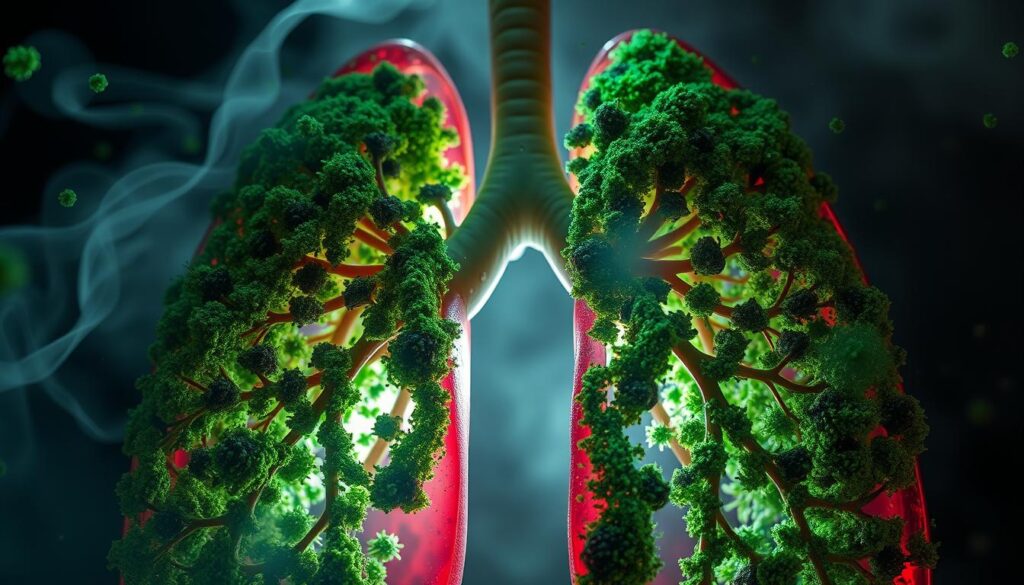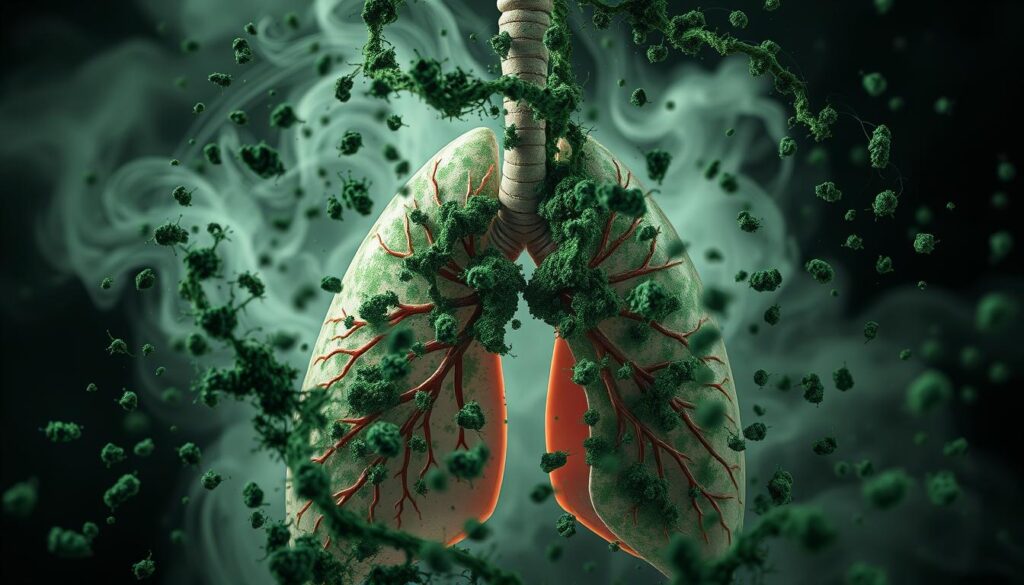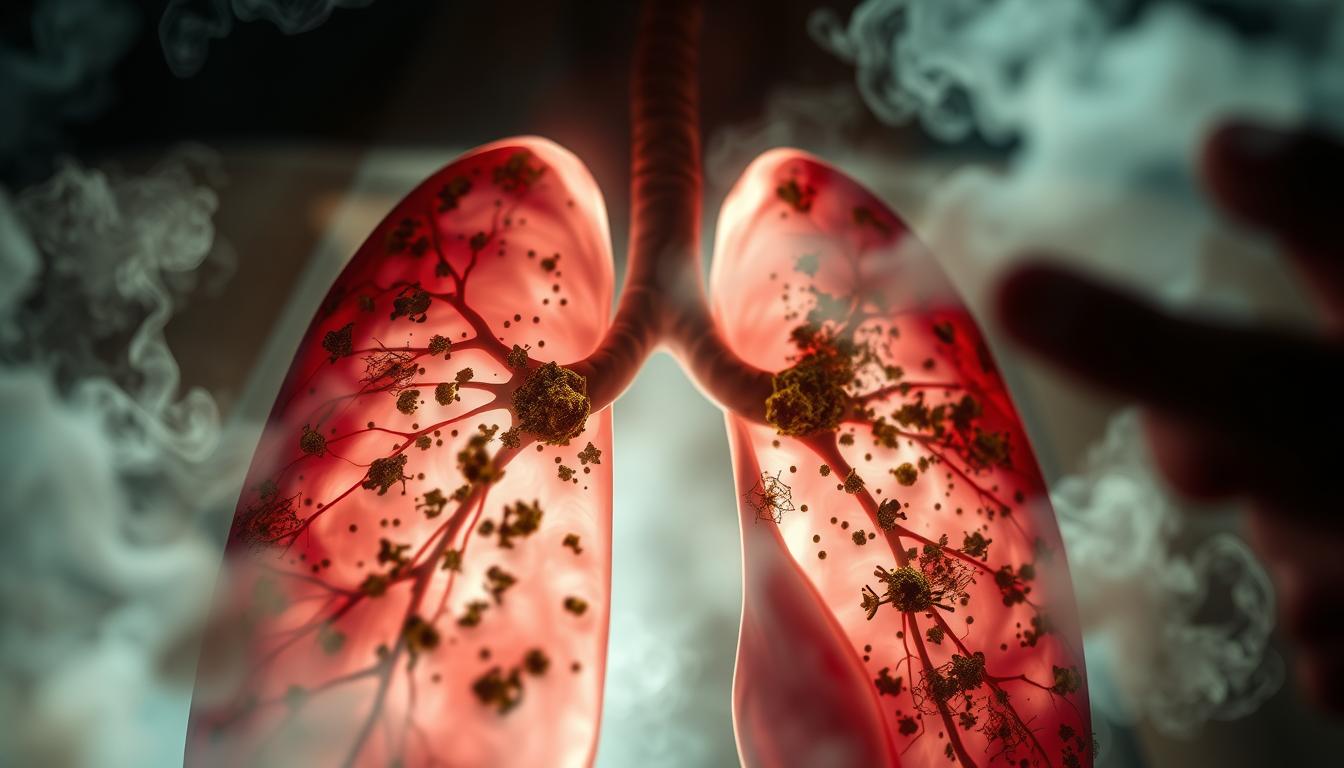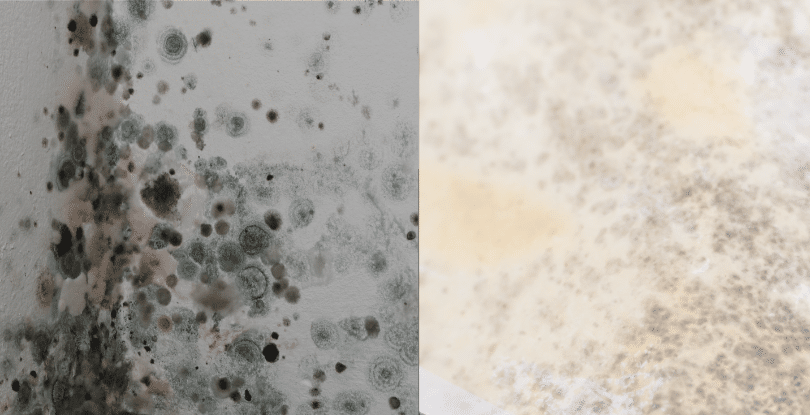Symptoms of Mould Spores in Lungs
Did you know that up to 2.5 percent of people with asthma worldwide react to molds in the Aspergillus genus? Mold spores, like those from black mold (Stachybotrys chartarum), can harm our lungs when we breathe them in. As someone who has dealt with mold-related lung problems, I know how important it is to watch for warning signs.
Symptoms of mold exposure can vary. They might include coughing, sneezing, or a runny nose. You could also have itchy eyes, a sore throat, or skin issues. Black mold, which grows in damp places with wood and paper, is a big problem. For those with mold allergies, symptoms can start right away. Others might notice them later.
If you have breathing problems, allergies, or a weak immune system, mold spores are a bigger risk. Knowing the signs and taking action can help keep your lungs healthy. This way, you can breathe more easily.
Key Takeaways
- Mold spores, like those from black mold, can cause breathing issues when inhaled.
- Symptoms may include coughing, sneezing, runny/stuffy nose, itchy eyes, throat, and skin.
- People with allergies, breathing problems, or weak immune systems are more at risk from mold.
- Being exposed to black mold can cause immediate or delayed symptoms.
- Watching for warning signs and taking steps to protect your lungs is key.
Understanding Mould Spores and Their Impact on Respiratory Health
Mold spores are tiny particles in the air that can harm our breathing. They come from black mold and release harmful substances. These can cause allergies and irritation in people who are sensitive.
What Makes Black Mould Dangerous
Black mold, or Stachybotrys chartarum, is very dangerous because it makes strong toxins. These toxins can cause breathing problems when we inhale them. Being around a lot of black mold can make symptoms worse, like lung infections and brain problems.
How Mould Spores Enter the Respiratory System
Mold spores can float in the air and get into our lungs. Once inside, they can make our body react, leading to coughing, wheezing, and trouble breathing. People with breathing problems like asthma or COPD can get even sicker from mold.
The Role of Environmental Factors
Mold grows in damp, poorly ventilated places with water damage. These conditions help mold spread and release more spores. Jobs that involve being around mold, like farming or carpentry, can also harm our breathing.
| Environmental Factor | Impact on Mould Growth |
|---|---|
| High Humidity | Provides the moisture needed for mold to grow and spread |
| Poor Ventilation | Allows mold spores to accumulate and concentrate in indoor spaces |
| Water Damage | Creates ideal conditions for mold to thrive and reproduce |
“Mold exposure can lead to a range of respiratory symptoms, from mild irritation to more severe conditions like lung infections. It’s crucial to address mold issues promptly to maintain a healthy indoor environment.”
What Are the Symptoms of Mould Spores in the Lungs
Mould spores can harm our lungs, causing many symptoms. These include coughing, wheezing, and shortness of breath. Chest tightness is another sign. These fungi can also trigger severe asthma attacks, which are dangerous.
Mould can also cause allergic reactions. Symptoms include sneezing, a runny nose, and itchy eyes and throat. Watery eyes are another sign of an allergic reaction to mould spores.
The severity of symptoms varies. Some people might just feel a bit uncomfortable. Others could face serious lung problems, like lung fungal infections or allergic bronchopulmonary aspergillosis. If you think mould is affecting your health, see a doctor right away.

“Mould exposure can have a significant impact on our respiratory health, leading to a range of concerning symptoms.”
Knowing the symptoms of mould spores in the lungs helps us act fast. Early treatment is key to keeping our lungs healthy. It prevents serious problems later on.
Common Signs of Mould-Related Respiratory Issues
Being around mold spores can lead to breathing problems. These can start right away or show up later. Knowing the signs is key to keeping your lungs healthy.
Immediate Respiratory Reactions
Mold spores in the air can make you cough, wheeze, or feel short of breath. These symptoms can happen fast, within minutes or hours. They might get worse if you stay in a moldy place.
Long-term Health Effects
Long exposure to mold can cause lasting breathing issues. You might cough a lot, feel tired, or lose weight without reason. People with asthma or lung problems might see their symptoms get worse.
Warning Signs That Require Medical Attention
Some breathing problems need to be seen by a doctor right away. This includes coughing up blood, fever, chills, chest pain, and severe asthma attacks. These could mean a serious infection or problem that needs quick treatment.
Mold can also cause infections in the skin, eyes, sinuses, or ears. This shows how important it is to take care of any breathing issues that don’t go away.
“Mold can trigger asthma symptoms in individuals with allergic asthma, and has been linked to the development of childhood asthma.”
Risk Factors for Developing Mould-Related Lung Problems
Being around mold can harm people with lung issues like chronic obstructive pulmonary disease (COPD), bronchiectasis, or. Long-term mold exposure can cause permanent lung damage. Babies, kids, the elderly, and those with weak immune systems are more likely to get sick from mold.
Living or working in damp, poorly ventilated places increases the risk of lung problems. Mold grows well in damp, dark areas, like after floods or storms. Drying water-damaged areas quickly, within 24-48 hours, can lower mold growth and exposure risks.
- Family history of allergies
- Occupational exposure to mold
- Living in high-humidity environments
- Residing in buildings with water damage or poor ventilation
- Existing respiratory conditions like asthma or COPD
- Compromised immune system
Mold can cause cough, throat irritation, wheezing, and more. These symptoms can be worse for those with lung problems. Mold can make their conditions worse and cause more health issues.
| Mould Exposure Risk Factors | Potential Health Impacts |
|---|---|
| Damp, poorly ventilated environments | Allergic reactions, respiratory infections, lung damage |
| Existing lung conditions (asthma, COPD, etc.) | Worsening of symptoms, increased risk of complications |
| Weakened immune system | Increased susceptibility to mold-related illnesses |
| Prolonged mold exposure | Irreversible lung damage, chronic respiratory problems |
To avoid mold-induced asthma and lung mold symptoms, keep your place dry and well-ventilated. Fix any water damage or leaks fast. If you have a big mold problem, get professional help.

“Mold exposure can have a significant impact on people with lung conditions, and prolonged exposure can even lead to irreversible lung damage. Maintaining a dry, well-ventilated environment and addressing any water damage or leaks is crucial to reducing the risk of mold-related health issues.”
Allergic Bronchopulmonary Aspergillosis: A Serious Complication
Allergic bronchopulmonary aspergillosis (ABPA) is a serious condition caused by an allergic reaction to Aspergillus fungus. It mainly affects people with lung problems like asthma or cystic fibrosis. If not treated, ABPA can cause serious lung damage, making early diagnosis and treatment key.
Diagnostic Criteria
The main signs of ABPA include:
- Asthma-like symptoms, such as cough, wheezing, and shortness of breath
- Elevated levels of immunoglobulin E (IgE) in the blood
- Presence of Aspergillus antibodies in the body
These signs help doctors spot the allergic reaction to Aspergillus fungus, which is central to ABPA.
Treatment Approaches
Treating ABPA involves using corticosteroids and antifungal drugs. Corticosteroids, like prednisone, lessen inflammation. Antifungal medicines, such as itraconazole or voriconazole, fight fungal growth. This combination is vital for managing symptoms and preventing lung damage.
ABPA can come back, so patients need ongoing care. They might need regular treatments to keep symptoms under control and stop the disease from getting worse.
Spotting and treating allergic bronchopulmonary aspergillosis early is crucial. It helps keep lungs healthy and lowers the risk of serious issues like lung fungal infection.
How Mould Exposure Affects Different Groups of People
Mold exposure affects people differently. Those with asthma, allergies, or breathing problems might be more sensitive. People with weakened immune systems, like those with HIV or cancer patients, face a higher risk of severe lung infections.
People with lung diseases like COPD are also at risk. Symptoms of hypersensitivity pneumonitis include fever and shortness of breath. But, most people won’t have serious health issues from mold.
To avoid mold and respiratory problems, keep air flowing and humidity low. Fix leaks and clean moldy areas quickly. For tough mold, use diluted bleach safely.
Mould Exposure and Farmers
Farmers are at high risk for lung diseases, with over 30 percent disabled by respiratory illness. Many affected farmers are nonsmokers, showing mold’s big role in their health.
Farmers can breathe in hundreds of thousands of mold spores a minute. This can cause farmer’s lung, a growing problem. Symptoms can last weeks and may cause permanent lung damage.
To prevent farmer’s lung, use mold inhibitors and ventilate buildings. Wear masks when handling moldy materials. Wetting down feed before handling can also help. Knowing who’s most at risk helps us tackle mold toxicity and respiratory illness better.
The Connection Between Mould and Respiratory Infections
Mold spores in our homes and workplaces can cause serious lung problems. These include aspergillosis and mold-induced asthma. It’s key to know how mold affects our breathing to prevent and manage these issues.
Types of Fungal Infections
Aspergillosis is a common fungal infection from mold. It can show up in different ways, like allergic bronchopulmonary aspergillosis. Each form has its own symptoms and treatment.
Mold from the Aspergillus genus can also trigger asthma. This can make asthma worse in people who already have it. Other fungi, like Mucormycetes, can be dangerous too, mainly for those with weak immune systems.
Prevention Strategies
To avoid lung fungal infections and respiratory problems, keep humidity low and air well-ventilated. Fix any water damage quickly. Regular cleaning and upkeep can also stop mold from growing.
Air purifiers with HEPA filters can help remove mold spores. This can lower the risk of getting sick. By reducing mold exposure, you protect your lungs and prevent serious health issues.
Diagnostic Methods for Mould-Related Lung Issues
Finding the cause of respiratory problems can be tricky, often due to mold exposure. Luckily, there are ways to figure out if mold is causing lung issues. Let’s look at how doctors use different methods to solve these health mysteries.
Doctors start by doing a detailed physical check and reviewing your medical history. They look for signs like breathing problems, skin issues, and allergic reactions. Skin prick tests and blood tests can spot mold allergies. Sputum analysis helps find fungal infections in the lungs.
Imaging tests like chest X-rays and CT scans show lung problems or fungal growths. Sometimes, a lung biopsy is needed for a clear diagnosis. Pulmonary function tests check how well your lungs work, giving clues about mold’s impact.
Doctors use these methods together to understand mold’s effects on lungs. This detailed approach helps them create effective treatment plans. It ensures each person gets the care they need for mold-related lung issues.
Early detection and action are crucial for mold-related lung problems. If you think mold is affecting your lungs, see a doctor. They can guide you through the needed tests and help you find relief.
Treatment Options and Medical Interventions
Managing mold-related lung issues often requires a mix of treatments. Medications can help ease symptoms and prevent more problems. For mold allergies, antihistamines like loratadine and cetirizine can reduce itching and sneezing.
Decongestants and nasal corticosteroids, such as fluticasone and budesonide, are also helpful. They manage nasal congestion and upper respiratory mold allergies.
Medication Options
Antifungal medications may be needed for fungal lung infections. For asthma-like symptoms from mold, inhaled corticosteroids and bronchodilators can help. Montelukast (Singulair) can block the immune system’s mold response but may cause side effects like anxiety and insomnia.
Alternative Therapies
Some people find relief in alternative therapies. Nasal irrigation with a neti pot or saline solution can clear mucus. Immunotherapy, or allergy shots, can also help by gradually desensitizing the immune system.
Dietary changes that boost respiratory health, like more antioxidants and anti-inflammatory foods, can also help. These changes can support medical treatment.
In severe cases, more intense treatments or surgery might be needed. It’s important to work with healthcare professionals to create a treatment plan that fits your needs.
FAQ
What are the symptoms of mould spores in the lungs?
Mold spores in the lungs can cause coughing and wheezing. You might also feel short of breath or have chest tightness. Sometimes, mold can even trigger severe asthma attacks.
What are the common signs of mould-related respiratory issues?
Mold can make you cough, wheeze, and feel short of breath right away. Long-term, it can lead to chronic breathing problems, fatigue, and weight loss. If you cough up blood, have a fever, or severe asthma, seek medical help.
What are the risk factors for developing mould-related lung problems?
Being allergic, working with mold, or living in damp places increases your risk. People with asthma or weakened immune systems are also more at risk.
What is Allergic Bronchopulmonary Aspergillosis (ABPA)?
ABPA is a serious condition caused by an allergic reaction to Aspergillus fungus. It’s diagnosed by symptoms like asthma, high IgE levels, and Aspergillus antibodies. Treatment includes corticosteroids and antifungal meds.
How does mould exposure affect different groups of people?
Children, the elderly, and those with breathing problems are more susceptible. Mold allergies can cause immediate symptoms. Immunocompromised people face a higher risk of severe infections.
What are the types of fungal infections caused by mould exposure?
Mold can cause aspergillosis, leading to allergic, chronic, or invasive forms. These can affect the lungs severely.
What are the diagnostic methods for mould-related lung issues?
Doctors use physical exams, medical history, and blood tests to diagnose. They might also do sputum analysis, chest X-rays, and CT scans. Sometimes, a tissue biopsy is needed.
What are the treatment options for mould-related lung issues?
Treatment includes antihistamines, decongestants, and nasal corticosteroids. Antifungal meds, inhaled corticosteroids, and bronchodilators are also used. Alternative options include nasal irrigation and dietary changes. In severe cases, more aggressive treatments or surgery might be needed.




